|
|
|
Sort Order |
|
|
|
Items / Page
|
|
|
|
|
|
|
| Srl | Item |
| 1 |
ID:
161699
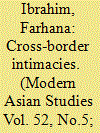

|
|
|
|
|
| Summary/Abstract |
This article examines intersections between sexuality, migration, and citizenship in the context of cross-border and cross-region marriage migration in Kutch, Gujarat, to underscore that women's mobility across borders is one site on which national cultural and political anxieties unfold. It argues that contemporary cross-region marriage migration must be located within the larger political economy of such marriages, and should take into account the historical trajectories of marriage migration in particular regions. To this end, it examines three instances of marriage migration in Kutch: the princely state's marriages with Sindh, nineteenth-century marriages between merchants from Kutch and women from Africa, and contemporary marriage migration into Kutch from Bengal. The article asks whether the relative evaluation of these marriages by the state can be viewed in relation to the settlement policies undertaken after partition, where borderlands were to be settled with those who were deemed loyal citizens. Finally, by historicizing marriage—as structure, but also aspirational category—it seeks to move away from the singularity of marriage as framed in the dominant sociological discourse on marriage in South Asia.
|
|
|
|
|
|
|
|
|
|
|
|
|
|
|
|
| 2 |
ID:
161694


|
|
|
|
|
| Summary/Abstract |
The purpose of this article is to examine what was involved when the great linguist George Grierson framed the history of Indian bhakti in terms of ‘the four churches of the reformation’ in one of his most widely read publications, ‘Bhakti-Mārga’, an entry in the Encyclopaedia of Religion and Ethics (1910). This was his translation of the concept of catuḥ (or cār) sampradāy, which plays a significant role in Nābhādās's Hindi Bhaktamāl (circa 1600). The weight of the target language and its enveloping culture (‘church’, ‘reformation’) raise obvious red flags. Grierson did not submit them to the sort of self-critical scrutiny we might today, nor did he examine the adequacy of Nābhādās's historiography. But did he get it all wrong? I will suggest that there are in fact some intriguing, if distant, analogies between the early modern world out of which Nābhādās wrote and its contemporary Protestant European counterpart, and I will ask whether Nābhādās may have been encouraged to adopt the framework he did because of precedents established in contemporary Muslim historiographical practice. In outlining his four sampradāys, Nābhādas played a role in creating a set of assumptions that long survived his own time in North India—and not just because Grierson would later be listening.
|
|
|
|
|
|
|
|
|
|
|
|
|
|
|
|
| 3 |
ID:
161696
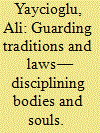

|
|
|
|
|
| Summary/Abstract |
This article examines the religious and intellectual dynamics behind the Ottoman military reform movement, known as the New Order, in the late eighteenth and early nineteenth centuries. Conventionally, the New Order has been examined within the framework of the Westernization of Ottoman military and administrative institutions. The Janissary-led popular opposition to the New Order, on the other hand, has been understood as a conservative resistance, fashioned by Muslim anti-Westernization. This article challenges this assumption, based on a binary between Westernization reforms versus Islamic conservatism. It argues that the Janissary-led popular opposition, which was consolidated long before the New Order, developed as a form of resistance by antinomian elements blocking the top-down disciplinary policies of the central state throughout the seventeenth and eighteenth centuries. The New Order programme, which was unleashed in 1792, was also opposed by the Janissary-led coalition, on the basis that it would wipe out vested privileges and traditions. Supporting the New Order, we see a coalition and different intellectual trends, including: (i) the Euro-Ottoman military enlightenment, led by military engineers and scientists, which developed an agenda to reorganize and discipline the social-military order with universal principles of military engineering and (ii) Islamic puritan activism, which developed an agenda to rejuvenate the Muslim order by eliminating invented traditions, and to discipline Muslim souls with the universal principles of revelation and reason. While the Euro-Ottoman military enlightenment participated in military reform movements in Europe, Islamic activism was part of a trans-Islamic Naqshibandi-Mujaddidi network originating in India. We thus witness a discursive alliance between military enlightenment and Muslim activism, both of which had trans-Ottoman connections, against a Janissary-led popular movement, which mobilized resistance to protect local conventions and traditions.
|
|
|
|
|
|
|
|
|
|
|
|
|
|
|
|
| 4 |
ID:
161700


|
|
|
|
|
| Summary/Abstract |
This article explores the history of the Husainabad Trust (‘the Trust’), a quasi-religious endowment that supported a number of key Shi‘a institutions in Uttar Pradesh (UP). It asks how Shi‘a elites were able to sustain their political clout and cultural independence in India whereas, in neighbouring Pakistan, they struggled. The fate of the Trust after independence led to a contest between the Shi‘as and the state, but also among Shi‘as themselves. The resulting confrontation between the Shi‘a community in Lucknow and across UP was, it shows, complicated by internal divisions among Shi‘as who, though united against state interference in their religious and royal trusts, were divided on how best to manage them. The Trust assumed importance for Shi‘as after independence because they lost some of the Trust properties to Pakistan and also because the Trust provided the means to support the largest public manifestation of Shi‘a presence in Awadh, Muharram. Husainabad, it suggests, helps to explain how and why Lucknow re-emerged after independence as the heartland of the Shi‘as of India, and arguably of South Asia.
|
|
|
|
|
|
|
|
|
|
|
|
|
|
|
|
| 5 |
ID:
161698
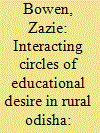

|
|
|
|
|
| Summary/Abstract |
Children from rural Odishan Scheduled Tribe and Scheduled Caste communities have an historically marginalized relation to schools and a corresponding greater involvement with informal education regimes and participation in everyday economic and cultural routines. Although radical state restructuring in recent decades makes rural school buildings more visible, inside the classrooms, students were often present and teachers absent. Drawing on ethnographic fieldwork, in Western Mayurbhanj, Odisha, I examine students’ engagement with school and argue that rural schools cannot be fully understood without examining the motivations of and interactions between three sets of stakeholders: state, local providers, and students. Further, the motivations, evaluations, and experiences of students deserve to be brought much more to the fore in light of their active roles in Mayurbhanj village schools and the significant effects of this involvement on both the nature of rural schools and the changes in rural blocks.
|
|
|
|
|
|
|
|
|
|
|
|
|
|
|
|
| 6 |
ID:
161702


|
|
|
|
|
| Summary/Abstract |
Exploring the rise and fall of government compradors, this article highlights Sino-British collusion in the corruption and extortion cases of the Hong Kong colonial government in the 1840s and the 1850s. A number of compradors worked for the Hong Kong colonial government throughout the nineteenth century, acting as a key communication channel between Chinese residents and colonial officials in the formative years of the colony. Various institutions of the colonial government, for instance the Colonial Treasury, Post Office, and British military, employed compradors. Colonial officials also personally employed compradors, who supported their principals’ work in the government. However, a symbiotic relationship between corrupt colonial officials and compradors had become a public problem by the mid-1850s. The colonial government responded to this by diversifying its Chinese staff rather than depending on monopolistic compradors, and also launched a scheme to nurture and employ British personnel who could act as intermediaries between the British and Chinese communities. At the same time, different kinds of Chinese intermediary elites emerged in Hong Kong from the 1860s onwards, and government compradors’ monopolistic authority in mediating between colonial officials and the Chinese public gradually declined. The volatile government comprador system highlights a key phase in the history of the evolution of the comprador system in Hong Kong.
|
|
|
|
|
|
|
|
|
|
|
|
|
|
|
|
| 7 |
ID:
161695
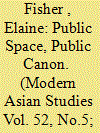

|
|
|
|
|
| Summary/Abstract |
What is ‘early modern’ about religion in South India? In theorizing early modernity in South Asia, the category of religion has been viewed with scepticism, perhaps to avoid painting India as the exotic ‘Other’ that failed to modernize in the eyes of Western social theory. And yet, Western narratives, drawn from secularization theory, fail to do justice to our historical archive. As a vehicle for approaching the experience of religion in early modern South India, this article invokes the category of space as a medium for the publicization and contestation of meaning across diverse language, caste, and religious publics. In the process, it excavates the codification of the ‘Sacred Games of Śiva’ as public religious canon of the city of Madurai, exemplifying the distinctive role played by religion in public space in early modern South India.
|
|
|
|
|
|
|
|
|
|
|
|
|
|
|
|
| 8 |
ID:
161701
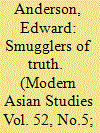

|
|
|
|
|
| Summary/Abstract |
During the Indian Emergency (1975–77) a range of opposition groups and the Indian state competed to mobilize the Indian diaspora. The Emergency therefore needs to be understood as a global event. Opposition activists travelled overseas and developed transnational networks to protest against the Emergency, by holding demonstrations in their countries of residence and smuggling pamphlets into India. They tried to influence the media and politicians outside India in an effort to pressurize Indira Gandhi into ending the Emergency. An important strand of ‘long-distance’ anti-Emergency activism involved individuals from the Hindu nationalist movement overseas, whose Indian counterparts were proscribed and imprisoned during the period. Several key Hindutva politicians in recent decades were also involved in transnational anti-Emergency activism, including Subramanian Swamy and Narendra Modi. The Rashtriya Swayamsevak Sangh's role in opposing the Emergency—particularly the way in which it enabled overseas Indians to act as ‘smugglers of truth’—remains an important legitimizing narrative for Hindu nationalists. Indira Gandhi's Congress government mounted its own pro-Emergency campaigns overseas: it attacked diasporic opposition activists and closely monitored their activities through diplomatic missions. The state's recognition of the diaspora's potential influence on Indian politics, and its attempts to counter this activism, catalysed a long-term change in its attitude towards Indians overseas. It aimed to imitate more ‘successful’ diasporas and began to regard overseas Indians as a vital political and geopolitical resource. The Emergency must be reassessed as a critical event in the creation of new forms of transnational citizenship, global networks, and long-distance nationalism.
|
|
|
|
|
|
|
|
|
|
|
|
|
|
|
|
| 9 |
ID:
161697
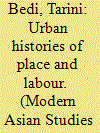

|
|
|
|
|
| Summary/Abstract |
When it comes to historical and ethnographic accounts of transport labour outside the West, scholars have only recently intervened to correct the paucity of systematic scholarship in this area. This article is in conversation with scholarship in both labour history and urban anthropology through which it links the modern history of a particular mode of urban transport (the taxi) and the labouring history of those who drive, move, and fix it. Through a focus on a community of hereditary taxi drivers known as chillia in the Indian city of Bombay/Mumbai, this article expands our understanding of labour experiences of the city through the twentieth century and into the present. It moves between historical archives, oral history, and lived experience to illuminate how the labour of transport workers structures circulations, collective identities, and urban space. It explores several dimensions of the history and present of transport labour in India. First, it is concerned with the connection between the work of hereditary motoring and the reconfiguration and constitution of communal identities in contexts of urban labour migration. Second, it is interested how labour practices become embedded in broader social and cultural space. Third, given that chillia have continued in the trade for over 100 years, the article explores the circuits of work and labour surrounding their trade to illuminate intersections between political and cultural shifts in Mumbai, changing conditions of work in contemporary contexts of globalizing capital, and the forms of ‘non-consent’ that emerge out of these networks.
|
|
|
|
|
|
|
|
|
|
|
|
|
|
|
|
|
|
|
|
|